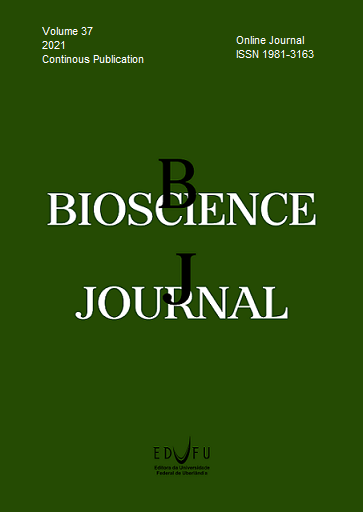RA92A recombinant protein as immunogen to protect cattle against tick challenge in Brazil and Uganda
DOI:
https://doi.org/10.14393/BJ-v37n0a2021-49905Keywords:
Immunogenicity, Ra92A protein, Rhipicephalus appendiculatus, Ticks, Vaccine.Abstract
In this study, the recombinant gut protein rRa92A produced in Pichia pastoris yeast cells was used to immunize cattle in two experiments, one in Brazil and the other in Uganda. In both experiments, the animals were intramuscularly (IM) injected with 200 µg of recombinant protein in Brazil on days 0, 30 and 51 and in Uganda on days 0, 30. Blood samples for sera separation were collected from different days in both experiments. These samples were analyzed by ELISAs. In Brazil, ticks collected from the animals during the experimental period were analyzed for biological parameters. At Uganda, blood was collected to assess blood parameters, clinical signs were recorded and adult tick (Rhipicephalus appendiculatus) counts were performed. All animals of the vaccinated groups were shown to produce antibodies, and it was not possible to detect an effect on Rhipicephalus microplus. All the clinical parameters were considered within the normal ranges for both the experimental and control groups in Uganda. Antibody absorbance was elevated after each immunization and remained high until the end of the experiments, remaining low in the control animals. The results of stall test carried out in Brazil using R. microplus tick showed efficacy of 21.95%. The rRa92A immunization trial experiments in Uganda showing a decrease of 55.2% in the number of engorged adult ticks, which was statistically significant (p<0.05). Assessment of the immunogenicity of Ra92A produced in the P. pastoris expression system in bovines is reported for the first time, and the protein acted as a concealed antigen.
Downloads
References
ANDREOTTI, R., et al. Protective immunity against tick infestation in cattle vaccinated with recombinant trypsin inhibitor of Rhipicephalus microplus. Vaccine. 2012, 30, 6678-3385. http://dx.doi.org/10.1016/j.vaccine.2012.08.066
Anon. National tick and tick-borne disease control strategy, Uganda, 1977.
BASTIDA-CORCUERA, F.D., et al. Differential complement activation by bovine IgG2 allotypes. Veterinary Immunology Immunopathology. 1999, 71, 115-123. https://doi.org/10.1016/S0165-2427(99)00095-1
CANALES, M., et al. Large-scale production in Pichia pastoris of the recombinant vaccine Gavac against cattle tick. Vaccine. 1997, 15, 414-422. http://dx.doi.org/10.1016/S0264-410X(96)00192-2
CUNHA, R.C., ANDREOTTI, R. and LEITE, F.P.L. 2013. Vacinas contra o carrapato-do-boi. In: ANDREOTTI, R., KOLLER, W.W., eds. Carrapatos no Brasil: Biologia, Controle e Doenças Transmitidas. Brasília, DF: Embrapa, pp.105-118
ESTES, D.M., et al. Expression and biological activities of bovine interleukin 4: effects of recombinant bovine interleukin 4 on T cell proliferation and B cell differentiation and proliferation in vitro. Cellular Immunology. 1995, 163, 268-279. https://doi.org/10.1006/cimm.1995.1126
FRASER, G.C., et al. Encephalitis caused by a Lyssavirus in fruit bats in Australia. Emerging Infectious Diseases. 1991, 2, 327-331. https://doi.org/10.3201/eid0204.960408
GARCÍA-GARCÍA, J.C., et al. Adjuvant and immunostimulating properties of the recombinant Bm86 protein expressed in Pichia pastoris. Vaccine. 1998, 16, 1053-1055. http://dx.doi.org/10.1016/S0264-410X(97)00266-1
GRAHAM, O.H. and HOURRIGAN, J.L. Eradication programs for the arthropod parasites of livestock. Journal Medical Entomology. 1977, 13, 629-658. https://doi.org/10.1093/jmedent/13.6.629
GRISI, L., et al. Reassessment of the potential economic impact of cattle parasites in Brazil. Revista Brasileira de Parasitologia Veterinária. 2014, 23, 150-156. http://dx.doi.org/10.1590/S1984-29612014042
GRÜNDER, H.D. 2006. Stefanofilariosis, In: DIRKSEN, G.T., GRÜNDER, H.D. and STÖBER, M., eds. Medicina Interna y Cirúrgia del Bovino. Buenos Aires: Inter-Médica, pp.66-68.
GUERRERO, F.D., MILLER, R.J. and DE LEÓN, A.A.P. Cattle tick vaccines: many candidate antigens, but will a commercially viable product emerge? International Journal Parasitology. 2012, 42, 421-427. https://doi.org/10.1016/j.ijpara.2012.04.003
HARRIS, N. and GAUSE, W.C. To B or not to B: B cells and the Th2-type immune response to helminths. Trends in Immunology. 2011, 32, 2. https://doi.org/10.1016/j.it.2010.11.005
KAMAU, L., et al. Differential transcription of two highly divergent gut-expressed Bm86 antigen gene homologues in the tick Rhipicephalus appendiculatus (Acari: Ixodida). Journal Insect Molecular Biology. 2010, 20, 105-114. https://doi.org/10.1111/j.1365-2583.2010.01043.x
MAIZELS, R.M., et al. Vaccination against helminth parasites--the ultimate challenge for vaccinologists? Immunological Reviews. 1999, 171, 125-147. https://doi.org/10.1111/j.1600-065x.1999.tb01345.x
MCGUIRE, T.C., MUSOKE, A.J. and KURTTI, T. Functional properties of bovine IgG1 and IgG2: interaction with complement, macrophages, neutrophils and skin. Immunology. 1979, 38, 249-256.
MERINO, O., et al. Tick vaccines and the control of tick-borne pathogens. Frontiers in Cellular Infection Microbiology. 2013, 3, 30. https://doi.org/10.3389/fcimb.2013.00030
OLDS, C., et al. Immunization of cattle with Ra86 impedes Rhipicephalus appendiculatus nymphal-to-adult molting. Ticks and Tick-Borne Disease. 2012, 3, 170-178. https://doi.org/10.1016/j.ttbdis.2012.03.003
PEGRAM, R.G., et al. Ecological aspects of cattle tick control in central Zambia. Medical Veterinary Entomology. 1989, 3, 307-312. https://doi.org/10.1111/j.1365-2915.1989.tb00233.x
PIPANO, E., et al. Immunity against Boophilus annulatus induced by the Bm86 (Tick-Gard) vaccine. Experimental and Applied Acarology. 2003, 29, 141-149. https://doi.org/10.1023/a:1024246903197
PLAYFORD, M. Review of Research Needs for Cattle Tick Control, Phases I and II. Sydney: Meat & Livestock Australia Ltd, 2005.
RUBAIRE-AKIIKI, C., et al. The prevalence of serum antibodies to tick-borne infections in Mbale District, Uganda: the effect of agro-ecological zone, grazing management and age of cattle. Journal of Insect Science. 2004, 4, 8. https://doi.org/10.1093/jis/4.1.8
SAIMO, M., et al. Recombinant Rhipicephalus appendiculatus gut (Ra86) and salivary gland cement (Trp64) proteins as candidate antigens for inclusion in tick vaccines: protective effects of Ra86 on infestation with adult R. appendiculatus. Vaccine. 2011, 1, 15-23. https://doi.org/10.2147/VDT.S20827
VARGAS, M., et al. Two initial vaccinations with the Bm86-based Gavacplus vaccine against Rhipicephalus (Boophilus) microplus induce similar reproductive suppression to three initial vaccinations under production conditions. BMC Veterinary Research. 2010, 6, 43. https://doi.org/10.1186/1746-6148-6-43
VUDRIKO, P., et al. Emergence of multi-acaricide resistant Rhipicephalus ticks and its implication on chemical tick control in Uganda. Parasite and Vectors. 2016, 9, 4. https://doi.org/10.1186/s13071-015-1278-3
Downloads
Published
How to Cite
Issue
Section
License
Copyright (c) 2021 Rodrigo Casquero Cunha, Margaret Saimo-Kahwa, Marcos Valério Garcia, Francisco Denis Souza Santos, Emukule Samuel, Nanteza Ann, Kokas Ikwap, Claire Julie Akwongo, Fábio Pereira Leivas Leite, Renato Andreotti

This work is licensed under a Creative Commons Attribution 4.0 International License.





